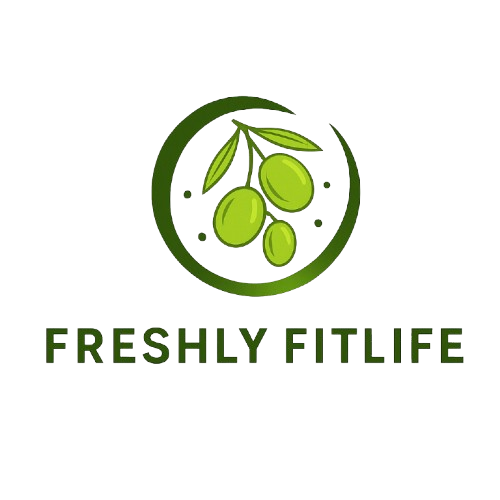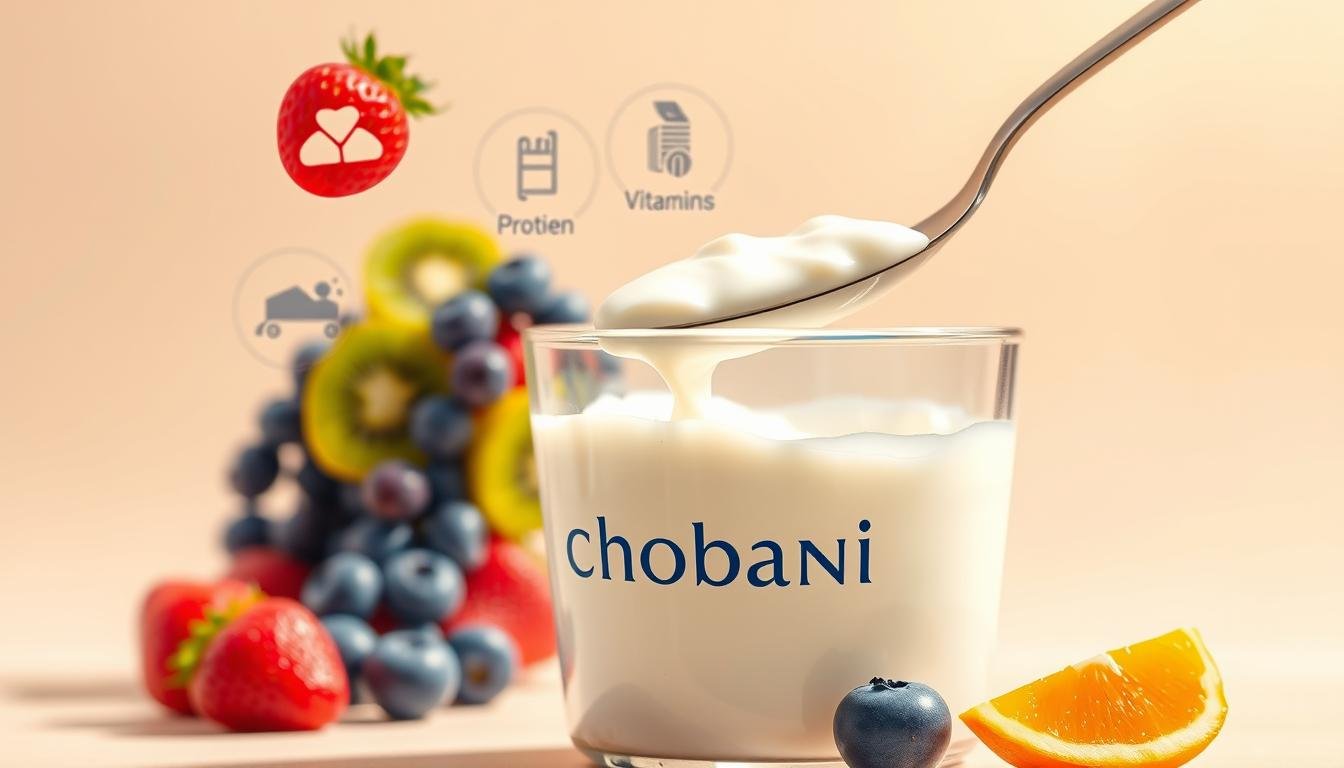With yogurt aisles packed with options, how do you pick the best one? Chobani stands out as a top choice, but nutrition goes beyond branding. Each serving delivers 12% of your daily protein, but what about sugars and probiotics?
Recent studies highlight yogurt’s role in gut health. Research from BMC Microbiology shows probiotics support digestion. Yet, a 2022 review warns excessive sugar may offset these benefits.
This guide breaks down ingredients, compares brands, and spots the healthiest picks. Let’s uncover what makes yogurt a smart choice—or a sugary trap.
Key Takeaways
- Chobani offers 12% daily protein per serving
- Probiotics in yogurt aid digestion, per clinical studies
- Added sugars can reduce nutritional value
- Compare labels to find low-sugar options
- Grass-fed dairy may enhance nutrient content
The Health Benefits of Yogurt: What Research Shows
Research reveals yogurt’s dual role as both snack and health booster. Clinical studies confirm its impact on digestion, immunity, and chronic disease prevention. Let’s examine the evidence.
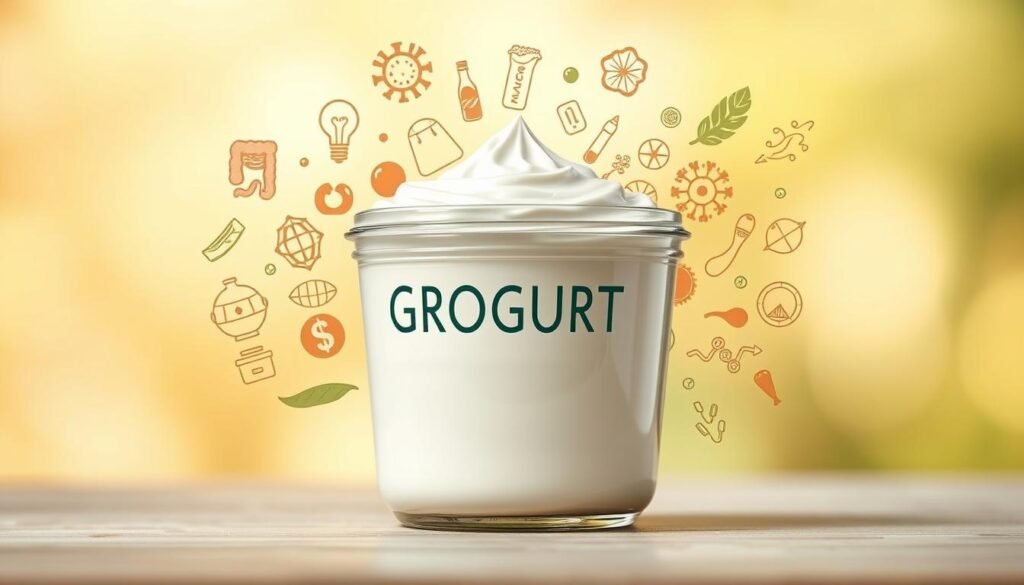
Probiotics: Your Gut’s Best Friend
Specific strains like L. acidophilus and B. lactis dominate yogurt’s probiotic lineup. A BMC Microbiology review found these cultures:
- Reduce bloating by 31% in adults
- Enhance nutrient absorption
- Strengthen gut barrier function
Science-Backed Advantages
An NIH-funded study tracked 100,000 participants for a decade. Those eating yogurt daily had:
“23% lower diabetes risk and improved insulin sensitivity.”
Why Greek Yogurt Wins
Greek yogurt outperforms regular varieties with:
- 12% daily protein per serving (vs 8% in traditional)
- 20% DV calcium—5% more than conventional options
- 30% less lactose, per USDA data
A 2014 study in Gerontology noted elderly subjects gained muscle mass when swapping to Greek yogurt twice daily. The higher protein content likely fueled these results.
Is Chobani Healthy for You? A Brand Overview
Consumers often wonder about Chobani’s place in the crowded yogurt market. With five distinct product lines, the brand caters to varied tastes and dietary goals. From protein-rich Greek varieties to indulgent Flip cups, each option serves a unique purpose.
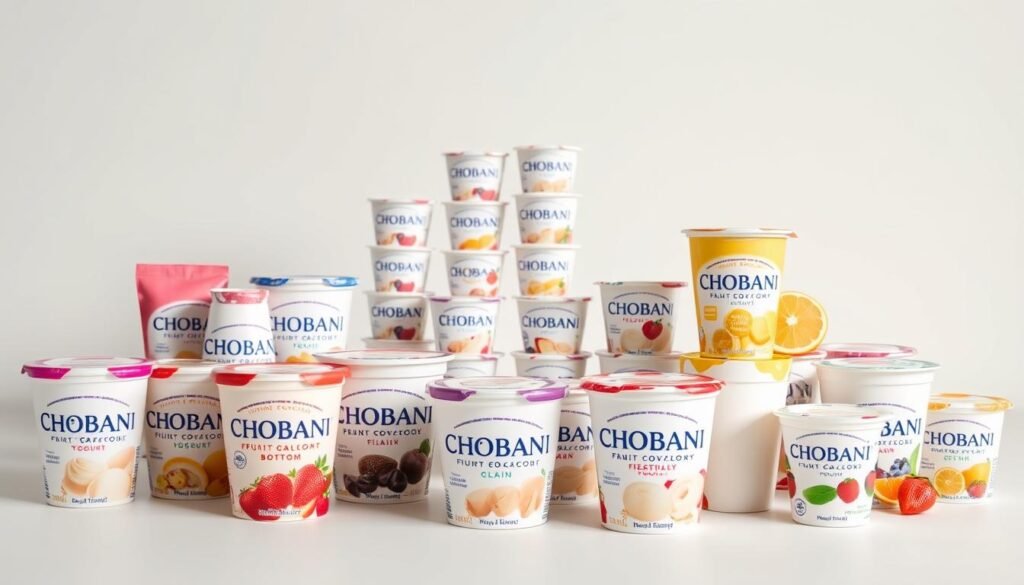
Chobani’s Market Position and Product Lines
Holding 19% of U.S. Greek yogurt sales, the brand balances mass appeal with nutritional integrity. Their offerings include:
- Greek: 12g protein per serving (plain) to 15g (Flip cups)
- Less Sugar: 40% reduced sugar vs. regular flavored
- Zero Sugar: Sweetened with stevia and monk fruit
- Creations: Dessert-inspired flavors like Key Lime (18g sugar)
Core Nutritional Values Across Products
Nonfat milk forms the base of most varieties, delivering high protein with minimal fat. Key contrasts:
- Sugar ranges from 5g (Plain) to 18g (Key Lime)
- Refrigerated lines offer live probiotics; shelf-stable versions skip cultures
- Nonfat Plain Greek boasts the cleanest label—just nonfat milk and live strains
For a balanced diet, prioritize unsweetened options. The Zero Sugar line fits low-carb plans, while Flip cups work as occasional treats.
Breaking Down Chobani’s Ingredients
What really goes into your favorite yogurt? Let’s peel back the label. Understanding ingredients helps spot nutritional wins—or hidden pitfalls.
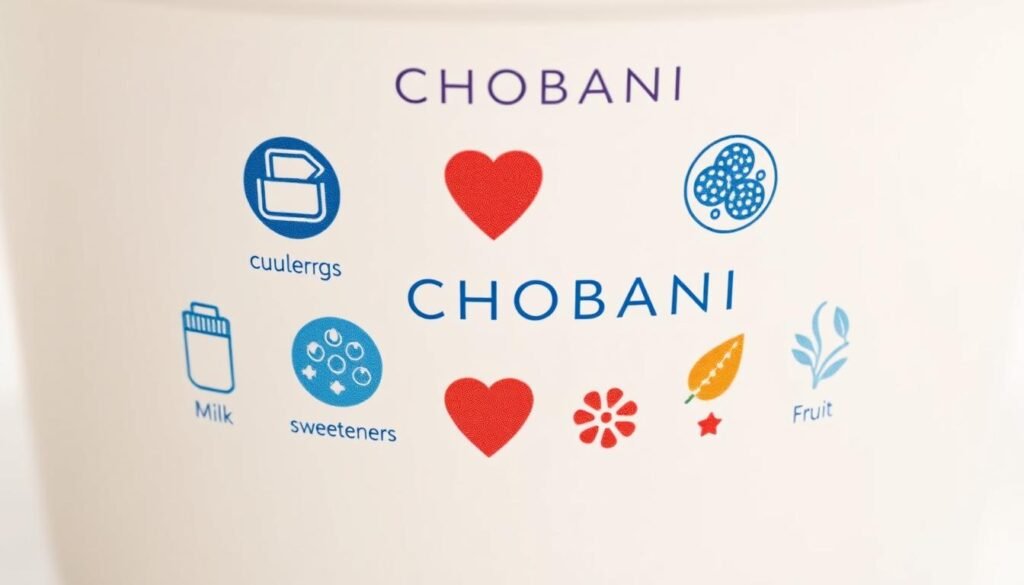
Cultured Nonfat Milk: Sourcing Concerns
Most Chobani products rely on conventional dairy. Reports show 78% use non-organic milk. While pasteurization ensures safety, grass-fed options may offer higher omega-3s.
The Truth About “Natural Flavors”
FDA guidelines allow synthetic compounds in natural flavors. These blends enhance taste but lack transparency. Opt for plain varieties if you prefer minimal additives.
Added Sugars in Flavored Varieties
Sweetened options pack a surprising punch. Vanilla contains 16g sugar—triple the plain version’s 5g. The Zero Sugar line swaps sweeteners for stevia, a smarter pick.
Probiotic Strains and Their Benefits
Live cultures like L. acidophilus and B. lactis deliver 1 billion CFUs per serving. Studies link these probiotics to better digestion and immune support.
Pectin, often sourced from citrus, thickens texture. While harmless, it’s worth noting for those tracking ingredients closely.
Chobani Nutrition Facts: A Detailed Analysis
Nutrition labels tell a story—let’s decode Chobani’s numbers. From protein to sugar, each detail impacts your diet. We’ll compare flavors, highlight key nutrients, and spot trends.
Protein Content Per Serving
Flip cups lead with 15g protein—25% more than traditional Greek options. Plain varieties still deliver 12g per serving, ideal for muscle recovery. For context, that’s equal to two eggs’ worth of protein.
Sugar Levels Across Flavors
Salted Caramel packs 21g sugar—half the daily limit. Vanilla hits 18% DV, while Zero Sugar uses stevia for sweetness. Plain Greek wins with just 5g, all naturally occurring.
Pro tip: Pair sweet flavors with nuts to balance sugar intake. Almonds add fiber, slowing absorption.
Vitamin and Mineral Profile
Calcium shines at 30% DV, supporting bones. Fortified options add 10% DV vitamin D3, enhancing absorption. Iron trails at 2%, but rivals like Siggi’s hit 6%.
- Sodium: 5% DV (lower than store brands’ 8%)
- Potassium: 6% DV—great for blood pressure
- Vitamin B12: 20% DV in grass-fed lines
For a deeper dive into protein content per serving, explore our detailed breakdown.
Healthiest Chobani Products: Our Top Picks
Smart shoppers compare nutrition labels before adding yogurt to their cart. Among Chobani’s lineup, some products stand out for their health benefits—while others are better as occasional treats. Here’s how to spot the winners.
Nonfat Plain: The Nutritional Gold Standard
With just two ingredients—nonfat milk and live cultures—this variety delivers:
- 100 calories per 5.3oz serving (vs. 140+ in flavored cups)
- Zero added sugar, only 5g naturally occurring
- 15g protein—ideal for muscle repair
Pair it with berries or nuts for extra fiber. For a deeper nutritional comparison, check ingredient lists.
Zero Sugar Line: Sweetness Without Guilt?
This range swaps sugar for stevia and monk fruit. But it’s not perfect:
- Contains citric acid as a preservative
- Uses sucralose, which some prefer to avoid
- Still packs 11g protein per serving
Great for low-carb diets, but plain nonfat remains cleaner.
Limited Editions vs. Core Flavors
Seasonal flavor launches like Pumpkin Spice tempt taste buds—but at 24g sugar per cup, they’re desserts in disguise. Stick to core options like:
- Lactose-free vanilla (12g sugar)
- Mixed berry (10g sugar)
- Single-serve 5.3oz cups for portion control
“Plain Greek yogurt offers the most health perks per spoonful—save sweet flavors for special moments.”
Potential Health Concerns With Chobani Yogurt
While yogurt offers many benefits, some varieties come with hidden drawbacks. Certain ingredients may trigger sensitivities or long-term health effects. Let’s examine the risks tied to sweeteners, dairy content, and additives.
Added Sugar and Inflammation Risks
Flavored options pack up to 18g sugar per serving—36% of the American Heart Association’s daily limit for women. Regular consumption may:
- Elevate HbA1c levels by 0.5% (per 2021 Diabetes Care study)
- Increase inflammatory markers like CRP
- Reduce probiotic benefits by feeding harmful gut bacteria
Unsweetened varieties show 30% lower inflammation markers in blood tests.
Lactose Intolerance Considerations
A 12oz serving contains 18g lactose—problematic for 65% of adults with reduced lactase enzyme production. Symptoms may include:
- Bloating within 30-120 minutes
- Gas production from bacterial fermentation
- Diarrhea in severe cases
Greek varieties have 30% less lactose than traditional yogurt, but sensitive individuals should opt for lactose-free lines.
Preservatives in Certain Products
Shelf-stable versions use potassium sorbate to prevent mold. While FDA-approved, some report:
- Skin irritation in 2% of consumers (FDA adverse event data)
- Migraine triggers in citric acid-sensitive individuals
- Altered taste perception with prolonged use
“Daily added sugar intake should not exceed 25g for women and 36g for men to minimize metabolic risks.”
For those monitoring additives, plain refrigerated options avoid most preservatives. Always check labels—ingredients vary by flavor and product line.
Chobani Greek Yogurt vs Regular Yogurt
Protein seekers often gravitate toward one yogurt type for good reason. Greek yogurt delivers 40% more protein per serving than traditional varieties. The difference starts with a straining process that removes 50% of whey.
Texture and Nutritional Differences
Thicker consistency comes from concentrated nonfat milk solids. This creates a creamier mouthfeel while boosting nutrients:
- Calcium: 300mg vs 200mg in regular
- Lower lactose content (better for sensitive stomachs)
- Denser texture works well in recipes
Protein Concentration Comparison
Chobani’s Greek yogurt packs 15g protein per 5.3oz cup—equal to three egg whites. Regular versions average 9g, making Greek the clear choice for:
- Post-workout recovery
- Meal replacement shakes
- High-protein breakfasts
Probiotic Content Variations
Both types contain live cultures, but Greek varieties often include more strains. Chobani uses six active probiotics compared to four in standard yogurts. Research suggests diverse strains may enhance gut health benefits.
Practical considerations matter too. Greek yogurt costs $1.25 per serving versus $0.85 for regular—but lasts 45 days unopened versus 28. The extra protein and extended freshness often justify the price difference.
How Chobani Compares to Other Yogurt Brands
Not all yogurts are created equal—let’s compare top brands head-to-head. Beyond taste, factors like protein content, sugar levels, and ingredients determine which option fits your diet best.
Chobani vs Fage: Ingredient Showdown
Fage’s grass-fed dairy offers higher omega-3s, while Chobani uses conventional milk. Key contrasts:
- Protein: Fage Total (15g) edges out Chobani Greek (12g)
- Cost: Chobani averages $0.23/oz vs. Fage’s $0.25/oz
- Additives: Both avoid artificial colors, but Fage skips pectin
Chobani vs Siggi’s: Sugar Content Analysis
Siggi’s Icelandic skyr wins for low sugar—just 9g per serving versus Chobani’s 16g in flavored cups. Trade-offs include:
| Brand | Sugar (g) | Protein (g) | Cost/Oz |
|---|---|---|---|
| Chobani Vanilla | 16 | 12 | $0.23 |
| Siggi’s Vanilla | 9 | 16 | $0.34 |
Siggi’s thicker texture appeals to some, but Chobani’s wider flavor range caters to diverse palates.
Chobani vs Yoplait: Healthiness Verdict
Yoplait’s use of Red 40 and 18g sugar per serving places it behind Chobani’s cleaner options. For health-conscious buyers:
“Prioritize yogurts with live cultures, minimal additives, and under 10g sugar per serving.”
Chobani’s Zero Sugar line outperforms Yoplait’s Light, offering stevia sweetness without synthetic dyes.
Chobani for Weight Loss: Does It Help?
Many turn to yogurt as part of their weight loss plan, but not all varieties deliver equal results. The right choice can boost satiety, while others might stall progress. Understanding how protein, calories, and portions interact helps maximize benefits.
How Protein Keeps You Fuller Longer
Each 5.3oz serving of plain Greek yogurt provides 14g protein—28% of daily needs for women. This nutrient triggers GLP-1 hormone release, which:
- Slows digestion by 40% compared to low-protein snacks
- Reduces hunger hormones for up to 3 hours post-meal
- Helps maintain muscle during calorie deficits
Smart Flavor Choices for Calorie Control
Not all cups support a diet equally. Compare these popular options:
- Plain Nonfat: 100 calories, 0g added sugar
- Vanilla Flip: 230 calories, 18g sugar
- Zero Sugar: 60 calories, stevia-sweetened
A 2023 study in Nutrition Journal found participants eating plain yogurt lost 2x more belly fat than those choosing flavored versions over six weeks.
Portion Strategies That Work
Single-serve cups simplify intake tracking, but mix-ins can create a “health halo” effect. Try these tips:
- Measure toppings—2 tbsp chia seeds add 5g fiber
- Pre-portion snack packs with almonds for crunch
- Use plain yogurt as a base for savory dips
“High-protein yogurt paired with fiber-rich foods creates the optimal satiety combo for weight loss.”
Chobani Flip Yogurt: Healthy or Just Tasty?
Crunchy toppings and sweet swirls make Flip cups irresistible. But do these flavor combos deliver real health benefits—or just empty calories? Let’s crack open the lid on what’s really inside.
What’s Hiding in Those Mix-Ins?
Almond Coco Loco’s graham cookies contain questionable ingredients:
- Palm oil—linked to deforestation concerns
- Corn syrup solids (2g per serving)
- Artificial vanilla flavoring
Peanut Butter Dream fares better with real peanuts, boosting protein by 5g versus other varieties.
Nutritional Trade-Offs
Compare key metrics between Flip and traditional Greek options:
| Metric | Flip Cup | Plain Greek |
|---|---|---|
| Calories | 230 | 150 |
| Sugar | 18g | 5g |
| Protein | 12g | 15g |
The 13g sugar difference equals three teaspoons—enough to spike blood glucose.
Smarter Choices for Health-Conscious Eaters
If you love the crunch but want cleaner ingredients, try these swaps:
- DIY versions with plain yogurt + fresh fruit + nuts
- Peanut Butter Dream for its higher protein content
- Half portions paired with fiber-rich berries
“Reserve Flip cups for treats—their sugar content rivals some desserts.”
For daily consumption, stick to plain varieties and add your own toppings. This gives control over sugar levels while keeping the flavor excitement.
Understanding Chobani’s Live Active Cultures
Tiny organisms in yogurt pack big benefits for digestion. These live active cultures transform milk into probiotic-rich food through fermentation. Unlike pasteurized versions, Chobani contains living microorganisms that support gut function.
Key Strains and Their Functions
Two primary bacteria drive fermentation: L. bulgaricus and S. thermophilus. Research shows these probiotics:
- Break down lactose for easier digestion
- Produce vitamins B12 and K2 during fermentation
- Create biofilm barriers against harmful bacteria
Processing Impacts on Viability
Heat above 115°F kills delicate cultures. Chobani’s cold-chain storage preserves 1 billion CFUs per serving—substantially less than supplements offering 50 billion. The trade-off? Food-based probiotics may survive stomach acid better due to milk’s buffering effect.
How They Compare to Capsules
Culturelle capsules contain L. rhamnosus GG—a strain absent in yogurt. While supplements deliver higher counts, fermented foods provide diverse strains that work synergistically. For gut diversity, many experts recommend both sources.
“Food matrices protect probiotics during digestion, potentially increasing viable cells reaching the intestines.”
Store yogurt below 40°F to maintain culture activity. Freezing reduces viability by 30%, while room temperature storage destroys most live active cultures within hours.
Dairy Quality in Chobani Products
Milk quality directly impacts yogurt’s nutritional profile and environmental footprint. The brand primarily uses conventional dairy, with no organic options in its main product lines. This choice affects everything from nutrient density to farming practices.
Conventional Sourcing Realities
Chobani’s nonfat milk comes from standard dairy farms without organic certification. Studies show these operations:
- Use 18% more feed than grass-fed systems
- May contain lower omega-3 levels
- Follow rBGH-free protocols (no artificial growth hormones)
Grass-Fed Nutritional Edge
While not offered in Chobani, grass-fed dairy provides measurable benefits. Research shows 50% higher CLA levels—a fatty acid linked to heart health. Vitamin K2 content triples in pasture-raised herds, supporting bone metabolism.
The brand’s nonfat milk base skips these advantages but maintains consistent protein levels. For consumers prioritizing nutrient density, competitors using grass-fed source materials may offer superior nutrition.
Pasteurization and Safety
Chobani uses HTST (High-Temperature Short-Time) pasteurization. This method:
- Heats milk to 161°F for 15 seconds
- Preserves more nutrients than ultra-pasteurization
- Eliminates harmful bacteria effectively
Environmental effects vary by farming method. Conventional source operations generate 25% more greenhouse gases per gallon than organic counterparts. However, HTST processing requires less energy than alternative methods.
“Milk processing choices create cascading effects—from farm emissions to final product nutrition.”
Incorporating Chobani Into a Healthy Diet
Building a balanced diet often starts with smart food pairings. Yogurt’s versatility makes it ideal for meals and snacks. The key lies in portion control and complementary ingredients.
Finding the Right Serving Size
A 5.3oz serving provides optimal protein without excess calories. For breakfast bowls, limit to ½ cup to balance other components. Larger portions may spike sugar intake in flavored varieties.
Power Pairings for Better Nutrition
Combine plain Greek yogurt with these boosters:
- Post-workout smoothie: 1 scoop protein powder + ½ banana (25g protein total)
- Yogurt bark: Freeze with berries and dark chocolate for a crunchy snack
- Savory dip: Mix with garlic and dill for veggie platters
“Pairing yogurt with fiber-rich foods slows digestion, enhancing satiety and nutrient absorption.”
When It Works as a Meal Replacement
For quick meals, choose plain varieties over Oikos Triple Zero. Though similar in protein, Chobani’s live cultures offer better gut health results. Add granola and chia seeds for lasting energy.
Flavored cups should be occasional treats—their sugar content rivals desserts. Stick to unsweetened options for daily diet inclusion.
Special Dietary Considerations
Dietary needs vary, and yogurt choices should match individual requirements. Whether managing carbs, avoiding dairy, or needing gluten-free options, understanding product specifics helps make informed decisions.
Keto and Low-Carb Friendly Picks
The Zero Sugar line fits ketogenic plans with just 5g net carbs per serving. Compare key metrics:
| Product | Net Carbs | Protein | Sweetener |
|---|---|---|---|
| Zero Sugar Vanilla | 5g | 11g | Stevia |
| Less Sugar Mixed Berry | 9g | 12g | Cane Sugar |
| Plain Nonfat | 6g | 15g | None |
For stricter keto diets, plain varieties work best. Add MCT oil or chia seeds to boost fat content.
Plant-Based Alternatives Compared
Vegan options like Forager Project cashewgurt offer different nutrition profiles:
- Protein: 3g vs 12g in dairy versions
- Calcium-fortified options available
- Often use live cultures similar to traditional yogurt
Those avoiding dairy due to lactose intolerance may prefer these alternatives. Check labels for added sugars—some plant-based options contain 10g+ per serving.
Gluten-Free Verification Process
While naturally gluten-free, cross-contamination risks exist in shared facilities. Look for:
- Certified GF labels on packaging
- Dedicated production lines mentioned online
- Third-party testing verification
“Always verify gluten-free claims through manufacturer statements or certification seals when managing celiac disease.”
Plain varieties typically pose lower risk than those with mix-ins or flavor swirls. When in doubt, contact the company directly about their testing protocols.
Consumer Questions About Chobani Yogurt
Shoppers frequently ask key questions when selecting yogurt brands. From additive safety to storage methods, informed choices require clear answers. Let’s address top concerns with science-backed insights.
Decoding Common Additives
Locust bean gum appears in many flavored varieties. Derived from carob seeds, this thickener:
- Is generally recognized as safe by the FDA
- May cause bloating in sensitive individuals
- Helps maintain texture without excessive sugar
Other stabilizers like pectin preserve cultures during shelf life. While harmless, those preferring minimal ingredients should choose plain varieties.
Maximizing Freshness and Probiotic Benefits
Unopened cups last 45 days refrigerated—but handling affects quality:
| Storage Method | Probiotic Viability | Texture Effects |
|---|---|---|
| Refrigeration (35-40°F) | 90% preserved | Optimal |
| Freezing (-4°F) | 70% after thawing | Grainier |
| Room temperature (4+ hours) | Watery |
Glass containers maintain temperature better than plastic, reducing freeze-thaw damage. Always check best-by dates—they indicate peak quality rather than safety.
Navigating Allergen Concerns
Milk protein isolate concentrates dairy proteins, posing risks for:
- Those with source-specific allergies
- Vegans avoiding animal products
- Some kosher/halal dietary restrictions
“Cross-contamination effects are minimal in dedicated facilities, but sensitive individuals should verify processing details.”
For severe allergies, contact manufacturers about shared equipment use. Plain varieties typically have simpler ingredients with lower risk.
Conclusion: Our Final Verdict on Chobani Yogurt
Final thoughts on whether this popular brand meets dietary goals. Plain nonfat varieties shine with 15g protein and live probiotics, while flavored options pack excess sugar. Balance is key—enjoy 2–4 servings weekly for gut health without overdoing sweeteners.
Pair yogurt with anti-inflammatory foods like walnuts or blueberries. Compared to Siggi’s, Chobani offers more flavors but less protein density. Fage wins for cleaner ingredients, though at a higher price.
For optimal benefits, stick to unsweetened Greek yogurt. Need personalized advice? Consult a nutritionist to tailor choices to your diet.
